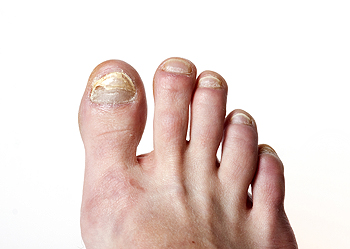 Toenail fungus, medically known as onychomycosis, affects a significant portion of the population, with fungal toenail infections being more common than those of the fingernails. These fungal infections can cause discomfort and affect nail appearance. Common symptoms include nail discoloration, thickening, and fragility, along with separation from the nail bed. Fungal toenail infections are caused by various environmental fungi that enter through small nail or skin cracks. Certain factors, such as age, nail trauma, diabetes, weakened immunity, and poor circulation, increase the risks of fungal toenail infections. Diagnosis requires laboratory testing to differentiate fungal infections from other nail problems. Treatment usually involves prescription antifungal medication, which is most effective when started early. However, recurrence is possible, especially in individuals with predisposing conditions like diabetes. If you have developed symptoms of fungal toenails, it is suggested that you make an appointment with a chiropodist for treatment.
Toenail fungus, medically known as onychomycosis, affects a significant portion of the population, with fungal toenail infections being more common than those of the fingernails. These fungal infections can cause discomfort and affect nail appearance. Common symptoms include nail discoloration, thickening, and fragility, along with separation from the nail bed. Fungal toenail infections are caused by various environmental fungi that enter through small nail or skin cracks. Certain factors, such as age, nail trauma, diabetes, weakened immunity, and poor circulation, increase the risks of fungal toenail infections. Diagnosis requires laboratory testing to differentiate fungal infections from other nail problems. Treatment usually involves prescription antifungal medication, which is most effective when started early. However, recurrence is possible, especially in individuals with predisposing conditions like diabetes. If you have developed symptoms of fungal toenails, it is suggested that you make an appointment with a chiropodist for treatment.
Toenail fungus can be uncomfortable and unsightly. If you have diabetes or a compromised immune system, it may also be dangerous. To learn more about treatment options, please consult with Paul A. Scotti, D.Ch from West Toronto Foot & Ankle Clinic Inc. . Our chiropodist will assess your condition and provide you with quality foot and ankle treatment.
What Does Toenail Fungus Look Like?
A fungal infection of the toenail may cause the affected nail to become thickened, brittle, crumbly, and yellowish or brown in color. Sometimes the toenail may separate from the nail bed, become deformed, emit a foul odor, or cause pain or discomfort.
What Causes Toenail Fungus?
Toenail fungus is caused by a fungus that infects the nail bed. The fungus lives and thrives in warm and moist environments and is also contagious. Athlete’s foot, which is a fungal infection of the skin, may spread to the nails and cause toenail fungus.
What Treatments Are Available?
Potential treatments for toenail fungus may include oral antifungal medications, topical antifungal medications, such as medicated nail polishes that are applied directly to the affected nail, and laser therapy. Sometimes, a combination of treatments is prescribed.
If you have any questions, please feel free to contact our office located in . We offer the newest diagnostic and treatment technologies for all your foot care needs.
